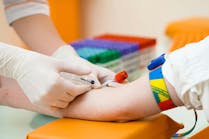Many
over-the-counter, or OTC, medicines containing pseudoephedrine,
ephedrine, or other sympathomimetic amines interfere with screening
tests for amphetamines but do not cause positive test results in the gas
chromatography/mass spectrometric, or GC/MS, confirmation, thus pose no
serious challenge in drugs-of-abuse (DOA) testing. In contrast, several
prescription medicines containing opioid, amphetamines, or other
ingredients can cause positive confirmed results in DOA testing. Use of
Marinol to control severe pain produces a positive confirmatory test for
marijuana metabolite (11-nor-9-carboxy-9-tetrahydrocannabinol;
THC-COOH) in urine.
Although the presence of benzodiazepines in urine
is not always tested in federal workplace drug testing (five Substance
Abuse and Mental Health Services Administration, or SAMHSA, drugs are
amphetamines, cocaine as benzoylecgonine, opiates, marijuana as
THC-COOH, and phencyclidine), private employers may test for
benzodiazepines in a drugs-of-abuse panel. It is important for an
individual undergoing workplace drug testing to report the use of such
prescription medication and name of the prescribing physician so the
Medical Review Officer can contact the physician and verify medical use
of such controlled substances. Otherwise, employment may be denied or
other adverse action may be taken by the employer against that
individual.
Interference with amphetamine/methamphetamine tests
Some prescription medications contain amphetamine or methamphetamine,
while the active ingredient of some prescription medication may be
metabolized to amphetamine or methamphetamine, causing positive
amphetamine/methamphetamine test results (see Table 1).1
For example, Adderall contains a mixed amphetamine salt widely
prescribed as a psychostimulant medication for attention deficit
hyperactive disorder, or ADHD, and use of such medication would cause a
positive amphetamine test. In January 2002, the U.S. Food and Drug
Administration approved Paremyd eye drops which contain
hydroxyamphetamine and tropicamide. Although amphetamine is metabolized
to hydroxyamphetamine, hydroxyamphetamine is not metabolized to
amphetamine. Therefore, use of such products should not cause a positive
amphetamine test result.
Opiate test results
Several
prescription medications for pain management contain morphine, codeine,
hydrocodone, oxycodone, or related opioid. Oxycodone has variable
cross-reactivity with different opiate-screening assays, and there is also a
specific immunoassay which recognizes the presence of oxycodone in urine —
but taking codeine or morphine containing analgesic medication produces
positive opiate test results in drugs-of-abuse testing. Ingestion of
fentanyl-containing drugs (which are also opioid) or use of the Duragesic
fentanyl patch should not cause a positive opiate test because fentanyl has
very poor cross-reactivity against antibodies used in opiate-screening
assays, which recognize morphine and related substances only.
Table 1. Drugs that contain amphetamine or methamphetamine, or metabolize to amphetamine or methamphetamine.
Marinol converts to marijuana metabolite
Although marijuana is a Schedule I drug, a synthetic
tetrahydrocannabinol (Marinol) is used for treating nausea and vomiting
in cancer patients undergoing chemotherapy and also as an appetite
stimulant to patients with AIDS. Because Marinol is also converted into
marijuana metabolite (THC-COOH), it causes positive marijuana test;
however, 9-tetrahydrocannabivarin (THCV), which is a natural
constituent of cannabis product, is absent in Marinol. THCV is
metabolized by human liver into THCV-COOH, and the presence of this
metabolite, in addition to THC-COOH in urine, indicates abuse of
marijuana rather than prescription use of Marinol.2
Benzodiazepines-containing drugs
Although benzodiazepine is not part of the
five federally mandated drugs for workplace testing, many private
companies test for benzodiazepines as a part of their employment
drug-testing program. Benzodiazepines is one class of the most
frequently prescribed drugs in the United States, and these are used
as tranquilizers, muscle relaxants, and anticonvulsants as well as
to treat symptoms of anxiety. More than 50 different types of
benzodiazepines exist, but not all 50 drugs are available in the
United States. The most commonly prescribed benzodiazepines in the
United States are diazepam, temazepam, alprazolam, lorazepam, and
clonazepam. Other examples of derivatives in this class include
areestazolam, halazepam, and quazepam.
Usually, immunoassay screening for
benzodiazepines recognizes the presence of common drugs and metabolites
after medical use or abuse. ElSohly, et al, analyzed benzodiazepines in
156 urine specimens from alleged victims of drug-facilitated sexual
assault and observed that oxazepam was confirmed in 50% of the specimens
followed by nor-diazepam (48%), temazepam (43%), and diazepam (40%),
while the presence of alprazolam was confirmed in 21.8% specimens and
lorazepam in 15.4% specimens.3
Propoxyphene medications
Propoxyphene, a milder narcotic analgesic
than benzodiazepines, is used in treating mild to moderate pain,
and is sold under trade names of Darvocet, Darvon, Propacet, and
Wygesic. Because this drug is also abused, it, too, is sometimes
tested in private employers’ workplace drug-testing programs.
Prescription use of propoxyphene may cause a positive test
result because the cut-off concentration for propoxyphene in
urine (300 ng/mL) can be reached after medical use of this drug.
Medical exposure to cocaine
Cocaine is used infrequently as a local anesthetic in ear, nose, and
throat surgery, and also is administered topically during ophthalmitic
procedures. Positive drug-testing results for cocaine (as
benzoylecgonine, the major metabolite) may be encountered in subjects
who have undergone such procedures. A patient may be positive up to 72
hours after an otolaryngologic procedure where cocaine is used as an
anesthetic. Cocaine metabolite can also be detected in the urine
specimen of the physician who is performing the procedure.4
Jacobson, et al, studied the effect of use of
ophthalmic solution containing cocaine on urine excretion of
benzoylecgonine in patients. Out of 50 subjects studied, 47 subjects
(94%) demonstrated a positive screening result for cocaine (as
benzoylecgonine) four to six hours after receiving eye drops. In
addition, 35 subjects (70%) showed positive results 24 hours after
receiving eye drops containing cocaine. The authors conclude that
ophthalmic administration of cocaine may cause positive test results up
to two days after procedure.5
Novocain, although synthetically derived from
cocaine, has a distinct structural difference from cocaine and the
metabolite of cocaine (benzoylecgonine). Therefore, use of Novocain
during dental procedures or use of other anesthetic agents, including
benzocaine, tetracaine, and lidocaine, should not cause false-positive
cocaine test results in urine DOA testing.
Conclusion
Because these drugs are
often abused, medical review officers and healthcare providers must be
aware of true positive results due to use of such drugs as lawful
medications. Verification of medical use of such drugs is important in
order to determine whether an individual tests positive for DOA due to
the medical use of such a drug with a valid prescription.
Amitava Dasgupta, PhD, is professor of Pathology
and Laboratory Medicine at the University of Texas Health Sciences
Center-Houston.
References
- Musshoff F. Illegal or legitimate use? Precursor compounds to
amphetamine and methamphetamine. Drug Metab Rev. 2000;32:15-44. - ElSohly MA, deWit H, Wachtel SR, Feng S, et al. Delta
9-tetrahydrocannabivarin as a marker for ingestion of marijuana versus
Marinol: results of a clinical study. J Anal Toxicol.
2001;25:565-571. - ElSohly MA, Gul W, Murphy TP, Avula B. LC-(TOF) MS analysis
of benzodiazepines in urine from alleged victims of drug
facilitated sexual assault. J Anal Toxicol.
2007;31:505-514. - Bruns AD, Zeiske LA, Jacobs AJ. Analysis of the cocaine metabolite
in the urine of patients and physicians during clinical use.
Otolaryngol Head Neck Surg. 1994;111:722-726. - Jacobson DM, Berg R, Grinstead GF, Kruse JR. Duration of positive
urine for cocaine metabolite after ophthalmic administration:
implications for testing patients with suspected Horner syndrome using
ophthalmic cocaine. Am J Ophthalmol. 2001;131:742-747.






